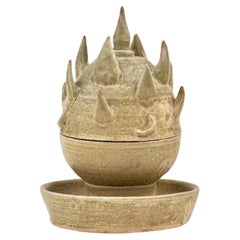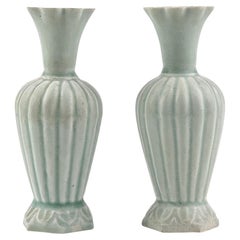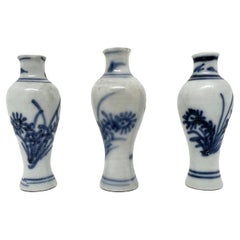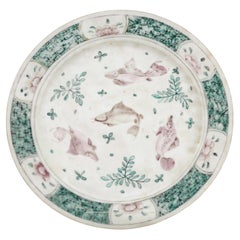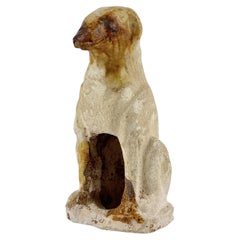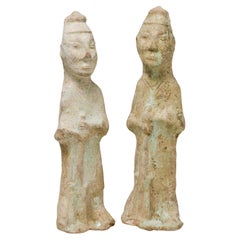South Korea - Antiquities
to
222
254
884
424
254
240
11
3
243
72
44
40
28
254
172
153
82
73
254
254
254
Item Ships From: South Korea
Rare Boshan Incense Burner Yue Celadon, Jin dynasty
Located in seoul, KR
The Boshan incense burner is particularly notable among Han dynasty incense burners for its unique shape. Designed to resemble a mountain or even a mythical mountain, it is characterized by its pointed peaks that rise upwards. These peaks often function as vents for the smoke, creating an effect reminiscent of a volcanic eruption.
The body of the incense burner is typically round, with multiple small peaks surrounding a central, larger peak. The material used is mainly ceramic, although there are instances where they were made of bronze. It is presumed that this incense burner was used for religious or ceremonial purposes during its time. The colors of these burners are usually in shades of pale green or greyish brown, with the application of glaze to achieve a variety of colors on occasion.
Such incense burners are often found in tombs or ritual sites, and their purpose was to burn incense for purification of space or to produce pleasant aromas. The Boshan incense burner also represents a significant cultural heritage, showcasing the craftsmanship and artistic values of the period. Today, it is considered a quintessential example of ancient Chinese art.
Period : Han-Jin Dynasty
Type : Incense Burner
Medium : Yue celadon...
Category
15th Century and Earlier Hong Kong Han Antique South Korea - Antiquities
Materials
Stoneware
$5,960 Sale Price
60% Off
Pair of Qingbai Vases, Song-Yuan Dynasty
Located in seoul, KR
This pair of Qingbai vases features a soft bluish-green glaze with elegant, fluted bodies and wide, flared rims. The vases are hand-crafted, with subtle differences that highlight th...
Category
15th Century and Earlier Hong Kong Antique South Korea - Antiquities
Materials
Porcelain
$2,183 Sale Price / set
44% Off
Three Blue and White Miniature Vases Set, C 1725, Qing Dynasty, Yongzheng Era
Located in seoul, KR
* Set Item(3 vases)
During Yongzheng era, such miniatures were appreciated for their craftsmanship and aesthetic value. They were also often used in scholars' studios as part of the...
Category
1720s Vietnamese Qing Antique South Korea - Antiquities
Materials
Ceramic
Chinese Famille Rose/Verte 'Fish' Dish, Qing Dynasty
Located in seoul, KR
During the Qing Dynasty, depictions of fish on ceramics carried several symbolic meanings. Fish are traditionally associated with abundance and prosperity in Chinese culture. The wor...
Category
17th Century Vietnamese Qing Antique South Korea - Antiquities
Materials
Ceramic, Porcelain
$1,228 Sale Price
35% Off
Amber-Glazed Pottery Figure of Dog, Tang-Liao Dynasty (7-12th Century)
Located in seoul, KR
A Dog sitting on his haunches, covered in an amber glaze. Naturalistically modeled, the figure follows the artistic style of the period. It remains uncertain whether the glaze has wo...
Category
15th Century and Earlier Hong Kong Tang Antique South Korea - Antiquities
Materials
Pottery
$1,943 Sale Price
35% Off
Two Green glazed Figures Holding Pitchpork, Han dynasty
Located in seoul, KR
Han dynasty pottery tomb figure, modelled standing holding a Pitchpork in front of his body, covered in a turquoise-green glaze. These two pieces are believed to have been produced i...
Category
15th Century and Earlier Hong Kong Han Antique South Korea - Antiquities
Materials
Pottery
$2,227 Sale Price / set
25% Off
Neolithic Pottery Amphora(Gansu Province), 3rd-2nd Millenium BC
Located in seoul, KR
Neolithic Jar with strap handle from Gansu Province. Acquired in Hong Kong in the late 1990s.
Date : 3,000-2,000 BC
Made in : Gansu province
Dimension : 23cm (Height) x 8.5cm(Mouth ...
Category
15th Century and Earlier Hong Kong Antique South Korea - Antiquities
Materials
Earthenware, Pottery
$2,275 Sale Price
35% Off
Small Celadon Chrysanthemum Dish, Northern Song Dynasty(AD 960~1127)
Located in seoul, KR
Potted with the fluted sides rising from a recessed base, carved to the interior with Chrysanthemum, covered overall with a grayish-green glaze, save for a ring to the underside left unglazed to reveal the gray stoneware...
Category
15th Century and Earlier Hong Kong Ming Antique South Korea - Antiquities
Materials
Celadon
$3,185 Sale Price
35% Off
A Cizhou Blackish Brown Glazed Stoneware Foliate Jar, Northern Song Dynasty
Located in seoul, KR
The jar is covered with a deep, warm blackish-brown glaze. The glaze is smooth and even, with a soft sheen.
The foliate rim has a gentle, wave-like design that gives the jar a natur...
Category
15th Century and Earlier Hong Kong Antique South Korea - Antiquities
Materials
Stoneware
$2,600 Sale Price
35% Off
Three Glazed Figures of Musicians, Ming Period (1368-1644)
Located in seoul, KR
Statues of Chinese musicians crafted from terracotta, featuring glazes in green, blue with nice condition. Set on rectangular bases. Compared to other figures, musician figures are relatively rare, two figures with distinctive instrument from that era.
Period: Ming Dynasty
Medium: Green and Blue glazed Pottery
Type: Figure
Provenance : Acquired in early 2000s from Hongkong
Reference :
1) V&A Museum - Accession number C.1501913
(Type : Closely related)
* Ming Dynasty Glazed Pottery Figures
Ming Dynasty glazed pottery figures are renowned for their bold color palette, intricate detailing, and lifelike forms, distinguishing them from earlier traditions. These figures, which depict officials, warriors, animals, and mythical creatures, are characterized by high-gloss lead-based glazes in green, amber, ochre, and sancai (three-color) combinations. The thickly applied glaze pools in recesses, creating depth and enhancing sculptural details. With dynamic postures, expressive facial features, and meticulously rendered drapery, these figures reflect the period’s advancement in ceramic craftsmanship, offering a greater sense of movement and realism compared to the rigid and stylized forms of earlier dynasties.
A defining characteristic of Ming glazed pottery is its elaborate surface detailing, often achieved through raised relief elements and contrasting glazes. Equestrian figures, for example, feature carefully sculpted saddles, harnesses, and decorative embellishments, while human figures are adorned with intricate robes and headdresses. The large scale of these tomb figures, often more imposing than those from previous periods, underscores the increasing importance of funerary art during the Ming era. Unlike later Qing Dynasty figures...
Category
15th Century and Earlier Hong Kong Ming Antique South Korea - Antiquities
Materials
Pottery
$1,943 Sale Price / set
35% Off
Green-Glazed Pottery ‘Money Tree’ Base, Han Dynasty
Located in seoul, KR
This piece, directly referred to as a Money Tree, is a captivating work that embodies wishes for material prosperity. It takes center stage in the Asian collections of institutions s...
Category
15th Century and Earlier Hong Kong Han Antique South Korea - Antiquities
Materials
Earthenware, Pottery
$19,500 Sale Price
35% Off
Green-glazed Pottery Amphora with Brown glazed Phoenix, Tang-Liao Dynasty
Located in seoul, KR
The vessel has an overall oval shape, characterized by smooth curves that transition naturally from the rim to the body. The upper part of the jar narrows slightly, with four handles...
Category
15th Century and Earlier Hong Kong Tang Antique South Korea - Antiquities
Materials
Pottery
$9,540 Sale Price
40% Off
Green and Ochre Glazed Altar Table with Offerings, Ming Dynasty, 15~16th Century
Located in seoul, KR
The table bearing pig head, rice cakes, dishes of meat, fish and fruit. Known as Mingqi, these terracotta models were customarily included in Chinese burial practices, particularly among the affluent, to aid the deceased in their journey through the afterlife. This tradition extends back to the Neolithic Period. A unique terracotta funeral table...
Category
15th Century and Earlier Hong Kong Ming Antique South Korea - Antiquities
Materials
Pottery
$2,730 Sale Price
30% Off
Green-glazed pottery tripod 'hill' jar, Han Dynasty, 206 BC - 220 AD
Located in seoul, KR
The modelled animal figures and landscapes of this piece represent the Daoist ideology of the Han dynasty. The mountain-shaped lid refers to the sacred dwellings of the immortals, th...
Category
15th Century and Earlier Hong Kong Han Antique South Korea - Antiquities
Materials
Stoneware
$2,242 Sale Price
25% Off
White Ware with two dragons, Yuan Dynasty, 13-14th century
Located in seoul, KR
This vase is made from a type of low-fired, porous clay and features a crackled glaze. It bears resemblance to the renowned funerary vases and covers adorned with applied decorations...
Category
15th Century and Earlier Hong Kong Antique South Korea - Antiquities
Materials
Ceramic, Porcelain
$1,245 Sale Price
50% Off
Famille Rose/Verte 'Crane and Flower' Baluster Vase, Qing Dynasty
Located in seoul, KR
The vase's form is elegant, with a tapered body and domed lid with long line of body, crowned with a delicate finial, embodying the sophistication and high aesthetic standards of Qin...
Category
17th Century Vietnamese Qing Antique South Korea - Antiquities
Materials
Ceramic
$838 Sale Price
35% Off
Changsha ewer, Tang Dynasty(618-907)
Located in seoul, KR
Changsha Ware has distinct and recognizable designs and motifs. Painted designs often depict flowers, vines, clouds and mountain landscapes. Some painting is simply splotches of colo...
Category
15th Century and Earlier Hong Kong Tang Antique South Korea - Antiquities
Materials
Stoneware
$3,196 Sale Price
60% Off
Cloisonné Enamel Vase, Early Ming Dynasty(15th century)
Located in seoul, KR
This exquisite vase is a fine example of Ming Dynasty cloisonné, an era renowned for revolutionizing the cloisonné technique with intricate design and vibrant enamel work. The cylind...
Category
15th Century and Earlier East Asian Ming Antique South Korea - Antiquities
Materials
Bronze, Enamel
$5,997 Sale Price
70% Off
Changsha Ewer, Tang Dynasty
Located in seoul, KR
It features two small lug handles on either side of the neck and a spout opposite the main handle. This ewer might have been used for wine or other liquids, which were poured through...
Category
15th Century and Earlier Hong Kong Tang Antique South Korea - Antiquities
Materials
Pottery, Stoneware
$1,516 Sale Price
60% Off
Celadon Ewer with Straight Handle, Tang to Northern Song Dynasty
Located in seoul, KR
Celadon-glazed ewer characterized by its simple and functional design. The piece features a straight handle extending horizontally from the body and a short spout for pouring liquids...
Category
15th Century and Earlier Hong Kong Tang Antique South Korea - Antiquities
Materials
Celadon
$2,925 Sale Price
35% Off
Extremely Rare Famille Noire Vases from Ca Mau Ship, Qing Dynasty, Yongzheng Era
Located in seoul, KR
Famille noire is a type of Qing Dynasty Chinese porcelain, distinguished by its black-glazed background with vivid natural motifs in green, yellow, and other bright colors. Developed...
Category
Early 18th Century Vietnamese Qing Antique South Korea - Antiquities
Materials
Ceramic, Porcelain
$2,240 Sale Price / set
30% Off
Two Pottery Kneeling Figures of Attendant, Han dynasty
Located in seoul, KR
The statuette shows traces of the original red, black, and white pigmentation. Ceramic statuette from the han Dynasty, depicting two court people, probably a musician. They are dress...
Category
15th Century and Earlier Hong Kong Han Antique South Korea - Antiquities
Materials
Pottery
$1,937 Sale Price / set
35% Off
Two Annamese Small Yuhuchunping, 15th century, Le Dynasty
Located in seoul, KR
These 15th-century Annamese ceramics from Le dynasty, are notable for their rarity and refined design. The Yuhuchunping vases, with their elegant pear-shaped bodies and delicate blue...
Category
15th Century and Earlier Vietnamese Ming Antique South Korea - Antiquities
Materials
Ceramic, Stoneware
$1,553 Sale Price / set
35% Off
Amber-Glazed Pottery Figure Of A Foreign Official, Tang-Liao Dynasty(7-12th c)
Located in seoul, KR
The figure stands with arms crossed in front, a pose that is often seen in tomb figurines which were intended to serve the deceased in the afterlife. The long robe and facial feature...
Category
15th Century and Earlier Hong Kong Tang Antique South Korea - Antiquities
Materials
Earthenware
$1,885 Sale Price
35% Off
Rare Cream Glazed Ding yao Ewer and Cover, Song Dynasty (960~1279)
Located in seoul, KR
This is a Song Dynasty ceramic ewer, exhibiting the characteristic simplicity and elegance of the period. The ewer's form is sturdy with a full-bodied base that tapers gently to a na...
Category
15th Century and Earlier Hong Kong Chinese Export Antique South Korea - Antiquities
Materials
Ceramic
$9,950 Sale Price
50% Off
Two white ware vases with flower design, Yuan Dynasty, 14th century
Located in seoul, KR
Porcelain with transparent pale-green (qingbai-type) glaze with flower, leaves and lotus design of typical yuan dynasty.
Period : Yuan Dynasty(1271-1368)
Type : Baluster vase
Medium...
Category
15th Century and Earlier Hong Kong Antique South Korea - Antiquities
Materials
Ceramic, Porcelain
$2,392 Sale Price
20% Off
Ancient Gu Shape Blue And White Vase, Qing Dynasty, Kangxi Era, Circa 1690
Located in seoul, KR
An attractive gu vase hand painted in cobalt blue with typical kangxi floral painting.
Period : Qing Dynasty, Kangxi Period
Production Date : 1690-1699
Made in : Jingdezhen
Destination : Netherland
Found/Acquired : Southeast Asia , South China Sea, Vung Tau ship
Reference : Double checked with reference to the original catalogues
1) Christies Amsterdam 1992 - Vung Tau Cargo / Christies
2) Qing Dynasty Export...
Category
1690s Vietnamese Qing Antique South Korea - Antiquities
Materials
Ceramic, Porcelain
$1,868 Sale Price
24% Off
Longquan Celadon Figurine, Ming Dynasty (1368-1644)
Located in seoul, KR
This sculpture is a Longquan celadon from the Ming Dynasty, renowned for its rich and jade-like green glaze. The figurine is likely a representation of a Buddhist deity or a revered scholar, showcasing the calm aesthetic expressions and graceful contours prevalent during the era. The spectrum of celadon glaze ranges from a dense grey stoneware to a nearly white porcelain texture, with unglazed parts revealing a terracotta brown upon firing. Such pieces were often part of household altars, reflecting the era's spiritual devotion. This artifact would be a treasured exhibit in any museum's Asian art collection, symbolizing both religious reverence and artistic excellence.
Period: Ming Dynasty (1368-1644)
Region: Longquan, China
Medium: Stoneware - Celadon glazed, with a range from heavy grey to almost white porcelain-like material
Type: Sculpture
Height : 24.5 cm
Provenance : Acquired in 1999, Hongkong
* Ming Dynasty Longquan Celadon
Longquan celadon from the Ming Dynasty typically exhibits a more robust and heavier stoneware body compared to its Song Dynasty predecessors. The Ming era saw an evolution in celadon glaze, achieving a wider spectrum of green hues, from olive to bluish-greens. Ming celadons...
Category
15th Century and Earlier Hong Kong Ming Antique South Korea - Antiquities
Materials
Celadon
$3,835 Sale Price
35% Off
Olive-Brown-Glazed Molded Ewer And Cover, Song-Yuan Dynasty
Located in seoul, KR
The oviform body molded with floral and leaf pattern reminiscent of waves, all covered with an olive-brown glaze. The glaze drips and irregular streaks of brown-glazed pottery from that period are distinctive aesthetic elements of Song-Yuan Dynasty brown glazed ceramics, with glaze colors ranging from deep chocolate to light amber or honey tones.
Date : Song-Yuan Dynasty(960~1368)
Type : Olive-Brown-glazed pottery
Provenance : Acquired in late 1990s from Hongkong
Reference :
1) Bonhams London 13 May 2024 - The John E. Bodie OBE (1930-2023) Collection of Chinese Art - Lot 12
(Price realised : 2,432 GBP / Type : Related)
2) Christies Mar 2015 - The Collection of Robert Hatfield Ellsworth...
Category
15th Century and Earlier Hong Kong Antique South Korea - Antiquities
Materials
Pottery
$2,786 Sale Price
30% Off
Green-Glazed Tripod Vessel, Han Dynasty
Located in seoul, KR
Han Dynasty green-glazed tripods are comparatively rare, especially ones that have retained their structural integrity and glaze over millennia. Pieces in good condition are scarce b...
Category
15th Century and Earlier Hong Kong Han Antique South Korea - Antiquities
Materials
Earthenware
$1,235 Sale Price
35% Off
Stone Head of Bodhisattva, Northern Wei-Tang Dynasties
Located in seoul, KR
The face with downcast eyes and a smile, the hair swept up behind the pendulous ears into a high topknot. Faint traces of pigmentation hinting at the sculpture's original polychromy. The black stand was made in Hong Kong at the time of the acquisition.
Date : Northern Wei-Tang Dynasty(5-8th century)
Provenance : Acquired in late 1990s from Hongkong
Reference :
1) Sotheby's London 13 May 2015 - The Soul Of Japanese Aesthetics – The Tsuneichi Inoue Collection - Lot 18
(Price realised : 17,500 GBP / Type : Closely related)
2) Sotheby's New York 26 September 2023 - CHINA / 5000 YEARS - Lot 1156
(Price realised : 8,890 USD / Type : Closely related)
* Stone Head of Bodhisattva...
Category
15th Century and Earlier Hong Kong Tang Antique South Korea - Antiquities
Materials
Limestone
$5,196 Sale Price
60% Off
White Ware Moulded Baluster Form, Yuan Dynasty, 14th century
Located in seoul, KR
This vase is made from a type of low-fired, porous clay and features a crackled glaze. It bears resemblance to the renowned funerary vases and covers adorned with applied decorations...
Category
15th Century and Earlier Hong Kong Antique South Korea - Antiquities
Materials
Ceramic, Porcelain
$950 Sale Price
50% Off
Longquan Celadon 'Dragon' Jar and Cover, Song Dynasty(1127–1279)
Located in seoul, KR
A similar jar with a cover, part of the Avery Brundage collection at the Asian Art Museum in San Francisco, is featured in Mary Tregear's "Song Ceramics" (London, 1982, plate 286). T...
Category
15th Century and Earlier Hong Kong Antique South Korea - Antiquities
Materials
Celadon
$6,950 Sale Price
50% Off
Sancai-Glazed Pottery Tripod Jar, Tang Dynasty
Located in seoul, KR
The globular body is supported on three claw feet and is covered in a splashed-glaze of amber, green and cream color, which stops short of the unglazed base.
Date : Tang Dynasty(61...
Category
15th Century and Earlier Hong Kong Tang Antique South Korea - Antiquities
Materials
Earthenware
$3,185 Sale Price
35% Off
Rare Figure of an Attendant Wearing Swirling Vest, Ming Dynasty(1368-1644)
Located in seoul, KR
Statues of attendant crafted from terracotta, dressed in a black coat-like garment with a vest adorned with swirling patterns. Set on rectangular bases.
Period: Ming Dynasty
Medium...
Category
15th Century and Earlier Hong Kong Ming Antique South Korea - Antiquities
Materials
Pottery
$1,995 Sale Price
50% Off
Vietnamese Blue And White Bowl Circa 15th Century
Located in seoul, KR
The artwork, with its foliage and floral motifs, suggests a connection to the natural world—a common theme in Vietnamese art. Such items were highly traded, and their recovery from shipwrecks helps us understand the extent of maritime commerce in Southeast Asia during the 15th and 16th centuries. This piece embodies the craftsmanship and aesthetic values of the period, providing insights into the cultural and economic contexts of its time.
Dates : 15th century Le Dynasty
Region : North Annam
Type : Bowl
Found/Acquired : Southeast Asia , South China Sea, Hoi An Ship
Reference : Double checked with reference to the original catalogue
Butterfield Treasures Hoi An Hoard Auction Catalogs / San Francisco Butterfields 2000
* Vietnamese trade ceramics
Around the mid-14th century, Vietnam developed its ceramics production technology by producing blue and white porcelain, and began to export it overseas. During this period, China Ming Dynasty implemented a policy of lifting the ban from 1371 to 1657 and restricted foreign trade. This served as a good opportunity in the trade history of Vietnamese ceramics...
Category
15th Century and Earlier Chinese Ming Antique South Korea - Antiquities
Materials
Ceramic, Stoneware
Black-Glazed Russet-Painted Bottle Vase, Northern Song-Jin Dynasty
Located in seoul, KR
Of broad pear shape rising from a low foot to a waisted neck and flared rim, covered overall with a lustrous brownish-black glaze with rare six bands of russet-strokes radiating in yuhuchunping shape.
Period : Northern Song-Jin Dynasty
Type : Yuhuchunping
Medium : Black glazed with russet painted
Provenance : Acquired in late 1990s from Hongkong
Reference :
1) Bonhams London 12 MAY 2016 - Fine Chinese Art - Lot 30
(Price realised : £ 37,500 / Type : Closely Related)
2) Bonhams London 11 MAY 2021 - Roger Keverne Ltd Moving On - Lot 99
(Price realised : £12,750 / Type : Related)
3) Christies NEW YORK 22 MAR 2018 - The Classic Age of Chinese Ceramics - The Linyushanren Collection, Part III - Lot 521
(Price realised : 35,000 USD / Type : Closely Related)
4) Christies HONG KONG 30 MAY 2024 - Important Chinese Ceramics and Works of Art - Lot 2854
(Price realised : HKD 201,600 / Type : Related)
* Black-glazed ceramics in Northern Song-Jin dynasty
Black-glazed ceramics, also known as "black ware," were prominent during the Northern Song (960–1127) and Jin (1115–1234) dynasties. The creation of these ceramics involved the application of a rich, dark glaze, typically achieved using iron oxide. This glaze was applied over a stoneware or porcelain body, then fired at high temperatures to produce a glossy, dark finish ranging from deep brown to black. Notable techniques included the "tea-dust" glaze, which exhibited a speckled appearance, and the "oil-spot" glaze, characterized by small, iridescent spots. The high-temperature firing process was crucial for achieving the desired glaze effects and durability.
The design of black-glazed ceramics often included intricate carvings, incised, or molded decorations. Common forms included bowls, vases, jars, and ceramic pillows. These pillows, used as headrests, featured detailed designs such as floral patterns, animals, and mythical creatures. An example of this is a black-glazed ceramic pillow from the Jin dynasty, which features carvings of two lions. Similar pieces can be found in the Guanfu Museum, where black-glazed pillows...
Category
15th Century and Earlier Hong Kong Antique South Korea - Antiquities
Materials
Stoneware
$6,396 Sale Price
60% Off
Amber-Glazed Pottery Ewer, Tang-Liao Dynasty (7-12th Century)
Located in seoul, KR
This historical piece features a robust, rounded body with a broad shoulder tapering down to a narrower base. The glaze, characterized by its rich amber hue, covers most of the vessel, while the lower part remains unglazed, exposing the rough, textured clay beneath.
Date : Tang-Liao Dynasty(7-12th century)
Type : Amber-glazed pottery
Provenance : Acquired in late 1990s from Hongkong
Reference :
1) Christies Newyork 1–15 DEC 2015 - Exquisite Splendor: Chinese Ceramics And Works Of Art - Lot 49
(Price realised : 5,250 USD / Type : Closely related)
2) Christies Newyork 18–27 MAR 2015 - The Collection of Robert Hatfield Ellsworth...
Category
15th Century and Earlier Hong Kong Tang Antique South Korea - Antiquities
Materials
Pottery
$2,394 Sale Price
40% Off
Funerary Model of a Granary, Han dynasty
Located in seoul, KR
Cylindrical vessel on three animal-shaped feet (dragon or snake), wall with profile grooves, roof. Ceramic with green transparent glaze. "Iridescence" is observed in surface.
Period...
Category
15th Century and Earlier Hong Kong Han Antique South Korea - Antiquities
Materials
Stoneware
$2,242 Sale Price
25% Off
Chinoiserie Teabowl Set Circa 1725, Qing Dynasty, Yongzheng Reign
Located in seoul, KR
Each teabowl is delicately painted with blue pigments, showcasing scenes of mountains, trees, boats, figures, and animals. The graceful brushstrokes and gentle curves evoke tradition...
Category
1720s Vietnamese Chinoiserie Antique South Korea - Antiquities
Materials
Ceramic, Porcelain
$973 Sale Price
30% Off
Ming Dynasty Green-Glazed Horse and Rider (15-16th Century)
Located in seoul, KR
Statues of Chinese horse and rider, featuring glazes in green, amber, are set on rectangular bases.
Period: Ming Dynasty
Medium: Green-glaze...
Category
15th Century and Earlier Hong Kong Ming Antique South Korea - Antiquities
Materials
Pottery
Sancai-glazed ‘floral’ dish, Liao dynasty(916~1125)
Located in seoul, KR
Well potted with shallow sides rising from a short foot, the interior molded with a single chrysanthemum surrounded by peony blossoms picked out in yellow and with green leaves again...
Category
15th Century and Earlier Hong Kong Tang Antique South Korea - Antiquities
Materials
Pottery
$3,495 Sale Price
50% Off
Two Incised Sandstone Mingqi, Five Dynasties and Ten Kingdoms period(907-979)
Located in seoul, KR
Figures from this era tend to be simpler and more utilitarian, reflecting the instability and regional diversity of the time. These pottery figures often unglazed or painted with bas...
Category
15th Century and Earlier Hong Kong Antique South Korea - Antiquities
Materials
Sandstone
$1,176 Sale Price
30% Off
Fish and Waterweed Teabowl and Saucer Set, c 1725, Qing Dynasty, Yongzheng era
Located in seoul, KR
* Set Item(Teabowl and saucer)
The saucer with four carp swimming among floating dumps of water weed, the teabowl with a central carp medallion within a band of smaller fish and wate...
Category
1720s Vietnamese Qing Antique South Korea - Antiquities
Materials
Ceramic
$392 Sale Price
20% Off
Haitai Figurine from Ca Mau Ship circa 1725, Qing Dynasty, Yongzheng Era
Located in seoul, KR
The green-glazed beasts seated on their haunches, a short spout beside their turned heads, their mane and tail splashed with yellow or brown glaze
Period : Qing Dynasty, Yongzheng P...
Category
1720s Vietnamese Chinoiserie Antique South Korea - Antiquities
Materials
Pottery
Green-glazed model of a shrine, Han dynasty
Located in seoul, KR
It has a pyramidal roof topped with a finial, ornamental ridges, and faux doors and windows that are characteristic of Chinese sacred architecture of the period.
Period : Han Dynast...
Category
15th Century and Earlier Hong Kong Han Antique South Korea - Antiquities
Materials
Stoneware
$2,992 Sale Price
25% Off
Two Blue and White Miniature Vases, C 1725, Qing Dynasty, Yongzheng Era
Located in seoul, KR
During Yongzheng era, such miniatures were appreciated for their craftsmanship and aesthetic value. They were also often used in scholars' studios as part of the 'wenfang', or study ...
Category
1720s Vietnamese Qing Antique South Korea - Antiquities
Materials
Ceramic
Two Annamese Mid-size Lidded Boxes with flower design, 15th century, Le Dynasty
Located in seoul, KR
Vietnamese stoneware cover boxes. These pieces exhibit a relatively vivid blue color compared to similar works from Hoi An hoard. Additionally, they are relatively larger in size amo...
Category
15th Century and Earlier Vietnamese Antique South Korea - Antiquities
Materials
Stoneware
$1,074 Sale Price
40% Off
Rare Annamese Stoneware with underglaze Blue and Painted Green, 15-16th Century
Located in seoul, KR
A bird on a tree. Stoneware with underglaze blue and painted green. The leaves were creatively expressed with green-glaze.
The use of green overpainting, a distinctive element in Annamese ceramics, parallels similar examples documented in The Age of Discovery: Asian Ceramics Found Along the Maritime Silk Road, particularly on pages 59, 64, and 66 of the Annamese ship catalog. Such pieces were widely traded along the Maritime Silk Road, showcasing the rich cultural exchange between Vietnam and other regions.
Dates : 15th century Le Dynasty
Region : North Annam, Vietnam
Type : Dish
Found/Acquired : Southeast Asia , South China Sea, Hoi An Ship
Reference : Double checked with reference to the original catalogue
1) Butterfield Treasures Hoi An Hoard Auction Catalogs / San Francisco Butterfields 2000
2) Asian Ceramic Found along Maritime Silk Route / National Maritime Museum of Korea
* Vietnamese trade ceramics
Around the mid-14th century, Vietnam developed its ceramics production technology by producing blue and white porcelain, and began to export it overseas. During this period, China Ming Dynasty implemented a policy of lifting the ban from 1371 to 1657 and restricted foreign trade. This served as a good opportunity in the trade history of Vietnamese ceramics, and ceramic exports...
Category
15th Century and Earlier Vietnamese Ming Antique South Korea - Antiquities
Materials
Stoneware
$2,593 Sale Price
35% Off
Kendi Blue And White, Qing Dynasty, Kangxi Period, C 1690
Located in seoul, KR
The Kendi is decorated with cobalt blue underglaze depicting flowers and a mythical bird, reflecting the artistic finesse and symbolic expressions of the era. These designs often carry symbolic meanings, with birds sometimes representing immortality or spiritual transcendence in Chinese mythology. The Kendi's form, with a bulbous body and spout for drinking, is a traditional vessel style in Asia, valued for both its functionality and aesthetic appeal.
Period : Qing Dynasty, Kangxi Period
Production Date : 1690-1699
Made in : Jingdezhen
Destination : Netherland
Found/Acquired : Southeast Asia , South China Sea, Vung Tau ship
Reference : Double checked with reference to the original catalogues
1) Christies Amsterdam 1992 - Vung Tau Cargo / Christies
2) Qing Dynasty Export...
Category
1690s Vietnamese Qing Antique South Korea - Antiquities
Materials
Ceramic
$1,950 Sale Price
50% Off
Longquan Celadon Five-Spouted Jar, Northern Song Dynasty (AD 960~1127)
Located in seoul, KR
Thickly potted with an ovoid body of five horizontal lobes tapering toward the top, carries both aesthetic and practical values. The jar is intricately carved with rows of upright lo...
Category
15th Century and Earlier Hong Kong Antique South Korea - Antiquities
Materials
Celadon
$1,885 Sale Price
35% Off
Large Block Print Blue and White Bowl c 1822, Tek Sing Cargo
Located in seoul, KR
This impressive, large-sized circular bowl, featuring hues of blue and white, showcases decoration through a block print technique. It is adorned with two horizontal bands of shou ch...
Category
1820s Indonesian Antique South Korea - Antiquities
Materials
Porcelain
A Rare Annamese Blue and white Ewer, Circa 15th century
Located in seoul, KR
Stoneware painted with underglaze cobalt blue and remnants of overglaze enamel. Valuable piece housed in a few major museum collections in the United States.
Year/Period : 15th century
Region : North Vietnam, Vietnam
Type : Ewer
Found/Acquired : Southeast Asia , South China Sea, Hoi An Ship
Reference :
1) Phoenix Art Museum - OBJECT NUMBER 2000.108.1
2) Asian Art Museum of San Francisco - Annamese Collection
3) Butterfield Treasures Hoi An Hoard Auction Catalogs / San Francisco Butterfields 2000
* Vietnamese trade ceramics
Around the mid-14th century, Vietnam developed its ceramics production technology by producing blue and white porcelain, and began to export it overseas. During this period, China Ming Dynasty implemented a policy of lifting the ban from 1371 to 1657 and restricted foreign trade. This served as a good opportunity in the trade history of Vietnamese ceramics, and ceramic exports...
Category
15th Century and Earlier Vietnamese Ming Antique South Korea - Antiquities
Materials
Stoneware
$4,543 Sale Price
35% Off
A Rare Moulded Dingyao 'Cranes And Fishes' Bowl, Northern Song - Jin Dynasty
Located in seoul, KR
This bowl stands out for its detailed depiction of two fish amid soft spiral waves, bordered by two cranes within the bowl. The design's depth and clarity, from the lifelike portrayal of the landscape to the cranes' meticulously detailed features, render this piece exceptionally unique and rare. Such complex designs on bowls were achieved using a mold, a method initiated at the Ding kilns in the late 11th or early 12th century, enabling heightened precision. These molds, akin to those for metal vessel casting, reflect a shared design aesthetic with contemporary metal objects.
Period : Northern Song-Jin dynasty(960~1234)
Type : Dingyao
Provenance : Acquired in late 1990s, Hongkong
Dimension : 19 cm(Height) x 8cm(Diameter)
Reference :
1) Sotheby's Hongkong 29 April 2022 - Important Chinese Art including Jades from the De An Tang Collection and Gardens of Pleasure - Lot 3695, Lot 3603
(Price : 1,890,000 HKD / Type : Closely related)
2) Sotheby's Hongkong 08 October 2019 Important Chinese Art - lot 3612
(Price : 3,000,000 HKD / Type : Related)
3) Sotheby's Hongkong 22 April 2021 - Monochrome III - Lot 30
(Price : 6,000,000-7,000,000 HKD / Type : Related)
4) The MET - Accession Number: 14.40.155 - Bowl with Peonies
(Type : Closely Related)
* Song Dynasty Ding-Yao Ware
Song Dynasty Ding Yao porcelain holds a significant place in Chinese ceramic art, specifically as a type of white porcelain produced during the Song Dynasty. Produced predominantly during the mid to late Song Dynasty, Ding Yao ceramics are renowned for their delicate and intricate features.
Ding Yao ceramics were primarily crafted from clay rich in white minerals and fired at high temperatures to achieve a durable and lustrous surface. One distinctive characteristic of this serene white ceramic is the presence of silver or gold-colored splashes of glaze, often created using a mineral called galena. Galena, with its lustrous appearance, was suitable for creating fine patterns and intricate decorations.
These ceramics frequently feature delicate carvings, floral motifs, or subtle decorations. While commonly used for utilitarian purposes such as tableware, Ding Yao porcelain also served as a medium for artistic expression, producing many artworks. The production of Ding Yao ceramics was relatively limited, and surviving pieces are considered rare and valuable art pieces...
Category
15th Century and Earlier Hong Kong Antique South Korea - Antiquities
Materials
Ceramic, Porcelain
$23,960 Sale Price
60% Off
Two Annamese Miniature Covered Boxes with Scenary Motif, 15th century, Le Dynast
Located in seoul, KR
Vietnamese covered boxes with representative scenary designs. Both are made of cream-colored base and blue designs, typical of Annamese pottery. These shared characteristics highligh...
Category
15th Century and Earlier Vietnamese Ming Antique South Korea - Antiquities
Materials
Stoneware
$954 Sale Price / set
40% Off
Guardian Official Pottery Figure, Northern Wei-Tang Dynasty
Located in seoul, KR
This figure appears to be a terracotta statuette, possibly representing a court official or a deity given the distinct headgear which could signify a rank or divine attribute. The style of the figurine, with its facial features and remnants of paint, suggests it could be a part of funerary art, which was common in Chinese culture during these periods.
Date : Northern Wei...
Category
15th Century and Earlier Hong Kong Tang Antique South Korea - Antiquities
Materials
Earthenware, Pottery
$1,895 Sale Price
50% Off
Crackle Glazed Bowl, Qing Period
Located in seoul, KR
Rounded form, covered with a glaze of a pale grey and yellowish tone with brown network of crackles.
Period: Qing Dynasty or Song Dynasty
Type: Bowl
Medium: Crackle Glazed
Size : 9...
Category
18th Century East Asian Qing Antique South Korea - Antiquities
Materials
Ceramic
$875 Sale Price
30% Off
Three Annamese Frog, parrot, monkey shape Waterdroppers, 15th c. Le Dynasty
Located in seoul, KR
With one hole on the back of the frog and the monkey in the mouth, body decorations. The central object appears to be a parrot-shaped ceramic, which might serve as a pouring vessel, ...
Category
15th Century and Earlier Vietnamese Antique South Korea - Antiquities
Materials
Ceramic
$2,392 Sale Price / set
20% Off
Carved 'Longquan' Celadon-glazed Funerary vase and cover, Song dynasty
Located in seoul, KR
The vase features a ribbed body, subtly enhancing its graceful contours, and is topped with a uniquely sculpted lid adorned with figurative elements.
Period : Song Dynasty
Type : Ce...
Category
15th Century and Earlier Hong Kong Antique South Korea - Antiquities
Materials
Celadon
$3,995 Sale Price
50% Off
The Romance of the Western Chamber Saucer, Qing Dynasty, Yongzheng Era c 1725
Located in seoul, KR
The scene depicted in the porcelain is inspired by "The Romance of the Western Chamber" (西厢记), which is one of the most famous Chinese classical novels and was among the first to be ...
Category
1720s Vietnamese Qing Antique South Korea - Antiquities
Materials
Ceramic
Recently Viewed
View AllMore Ways To Browse
Kimekomi Dolls
Luristan Bronze
Luristan Dagger
Monkey Gong
Pegu Bronze
Ruo Shen
Wheat Thrasher
11th Century Vishnu Stone Statue
Antique Cast Iron Hibachi
Dinosaur Statue
Han Dynasty Stick Man
Leather Rice Paddy Shoes
Vintage Bone China Flowers
Vintage Bull Figurine
Vintage Cast Iron Fire Basket
Vintage Ceramic Pig
Vintage Cowboy Saddle
Vintage Dragon Figurine
